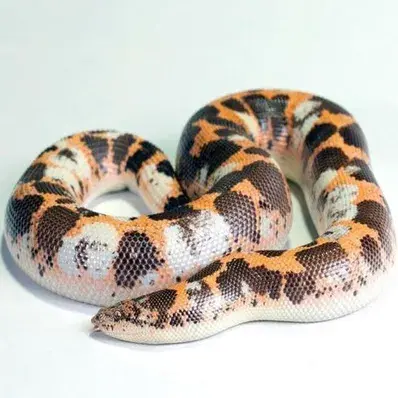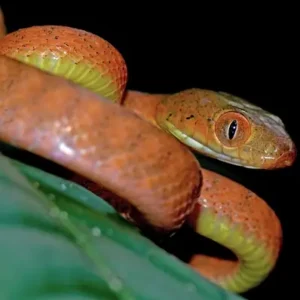Origin and Habitat
The Kenyan Sand Boa Eryx Colubrinus is native to the arid landscapes of East Africa, specifically Kenya and Tanzania.
Adapted to sandy terrains, the East African Sand Boas are skilled burrowers, navigating the semi-arid regions with ease. Their streamlined bodies and specialized scales facilitate efficient movement through loose soils.
In their native habitat, characterized by savannahs and grasslands, Kenyan Sand Boas exhibit nocturnal behavior, emerging from burrows during the night to hunt. Their survival strategies include remaining hidden beneath the sand, providing camouflage against both prey and predators.
Understanding their East African origins is crucial for effective captive care. When kept as pets, replicating the sandy substrate and temperature gradients of their natural habitat ensures their well-being.
Personality
Kenyan Sand Boas are a great choice for those who are new to petting snakes. They are known for their gentle disposition and are not prone to frequent biting. In fact, they usually retreat rather than confront, both in the wild and as pets.
In captivity, they prefer hiding rather than engaging in direct conflict, making them a low-risk choice. While occasional bites may occur, especially if they mistake a hand for food, careful handling ensures a safe and enjoyable experience.
Plus, they don’t get very large in size. Full-grown Kenyan Sand Boas grow to be around 26 inches. This optimal size also makes a good beginner friendly pet snake option.
Physical Appearance
Kenyan Sand Boas are relatively small, reaching lengths of 14-24 inches. This makes them suitable for pet owners with limited space.
They have a narrow, pointed head with small eyes and nostrils to protect them from the sand. Their bodies are smooth, robust, and thick, and their tails are short and stubby. One of the most beautiful traits of this Sand Boa is their markings.
They have a tan, yellow, or orange base color spotted with dark brown, camouflage-like splotches. Their underbellies are typically white or cream.
Gender Differences
Kenyan Sand Boas showcase a marked contrast between males and females in both size and physical characteristics.
Females, being the larger of the two genders, typically range from 25 to 32 inches, while males measure a more modest 15 to 18 inches.
Additionally, both males and females possess vestigial legs known as “spurs” near their vent, with males exhibiting longer spurs compared to their female counterparts.
Feed/Nutrition
Kenyan Sand Boas are carnivorous, primarily consuming appropriately sized rodents. Feed adult boas every 10-14 days, adjusting the size of prey items as they grow. Ensure that the prey items are appropriately sized to avoid regurgitation.
Here’s a handy Kenyan Sand Boa feeding chart to help you plan out your pet’s diet:
| Age/Size | Prey Size | Feeding Frequency |
| Babies | Pinky mouse | Every 5-7 days |
| Juveniles | Fuzzy mouse | Every 1-2 weeks |
| Adult Males | Hopper mouse | Every 2-4 weeks |
| Adult Females | Small adult mouse | Every 2-4 weeks |
| Large Adult Females | Medium adult mouse | Every 2-4 weeks |
Health
Kenyan Sand Boas are generally healthy animals and can live over 30 years in captivity. Here are some common health concerns for these boas:
- Respiratory Illness: Maintain appropriate humidity levels to prevent respiratory issues. Signs of respiratory distress include wheezing, open-mouth breathing, or nasal discharge.
- Scale Rot: This bacterial infection can occur when the substrate is consistently damp. Keep the enclosure clean and dry to prevent scale rot.
- Mouth Rot: Poor oral hygiene or injuries can lead to mouth rot. Regularly inspect their mouths for signs of infection, such as swelling or discoloration.
- Mites: External parasites, such as mites, can affect Kenyan Sand Boas. Regularly inspect their skin and substrate for any signs of these tiny pests.
Kenyan Sand Boa Care and Housing
While this species of snakes, relatively low-maintenance, thrive under specific conditions that mimic their natural habitat.
When it comes to housing these captivating reptiles, a secure enclosure with appropriate environmental parameters is essential. A glass or plastic terrarium of at least 20 gallons is suitable for adult boas, with secure lids to prevent escape.
- Substrate
Given their affinity for burrowing, provide a substrate that allows them to exhibit this natural behavior. Aspen shavings, coconut coir, or a sand-soil mix are excellent choices, offering a comfortable and naturalistic environment.
- Temperature and Lighting
Maintaining proper temperature gradients is crucial.
Provide a warm side of the enclosure with a room temperature range of 85-90°F (29-32°C) and a cooler side around 80 degrees Fahrenheit to 95 degrees (24-27°C).
A heating pad or heat lamp can be used to achieve these gradients. While Kenyan Sand Boas do not require UVB lighting, providing a day-night cycle with a natural light source supports their overall well-being.
- Humidity
Maintain a humidity level of around 40-50%, mimicking the drier conditions of their native environment. This can be achieved by misting one side of the enclosure and ensuring proper ventilation.
- Hide Boxes
Include hiding spots on both the warm and cool sides of the enclosure. Half logs, cork bark, or commercially available hides create secure retreats where your boa can feel safe and reduce stress.
Rescue Groups
Rescue groups offer a vital opportunity for those looking to adopt or find assistance for Kenyan Sand Boas, providing a second chance for these captivating reptiles.
Kenyan Sand Boa for Sale
For those interested in bringing a Kenyan Sand Boa into their homes, reputable breeders and exotic pet stores are good sources. Ensure that the breeder adheres to ethical practices and prioritizes the well-being of their animals.
Interesting Facts
- Kenyan Sand Boas are proficient burrowers, spending a significant amount of time beneath the substrate.
- They have a unique method of ambushing prey by hiding beneath the sand and striking when an unsuspecting meal passes by.
Best For
Kenyan Sand Boas are ideal for reptile enthusiasts looking for a captivating and manageable snake that doesn’t require extensive space.
Top Names
| Male Kenyan Sand Boa Names | Female Kenyan Sand Boa Names |
| Apollo | Luna |
| Titan | Ember |
| Zephyr | Seraphina |
| Orion | Willow |
| Blaze | Ivy |










